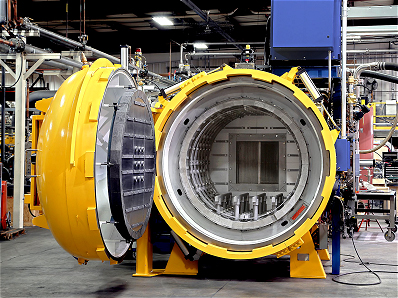
In this specific space of furnace chamber, the vacuum system is used to partially discharge the material in it, so that the pressure in the furnace chamber is less than one standard atmospheric pressure, and the furnace chamber thus achieves a vacuum state. The vacuum furnace can realize the process of vacuum quenching, vacuum tempering, vacuum annealing, vacuum solution and vacuum aging treatment, vacuum sintering, chemical vacuum heat treatment and vacuum coating, etc. It can realize complex processes that other heat treatment equipment cannot handle.



The vacuum furnace can perform high temperature heat treatment at 1200°C, medium temperature at 950°C, and low temperature at 650°C. The heating system in the furnace can be directly heated by electric resistance wire, or it can be heated by high-frequency induction. The maximum temperature can reach about 3000℃. Mainly used for ceramic firing, vacuum smelting, degassing and annealing of electric vacuum parts, brazing of metal parts, and sealing of ceramics and metals, etc..
It can be used in the aviation and aircraft manufacturing industry, automobile manufacturing industry, and precision machinery manufacturing industry to perform heat treatment and spheroidizing annealing such as heating without oxidation or decarburization, quenching, annealing, and tempering on precision parts. It can also be used in the non-ferrous metal industry for copper materials’ bright and non-oxidation annealing, it can also be used for vacuum sintering of metal or non-metal materials and parts in the petroleum machinery industry.
Vacuum Furnaces generally use electric heating, but there are still differences in heating methods, which are divided into internal heating vacuum furnaces and external heating vacuum furnaces. According to the requirements of vacuum degree, it is divided into high vacuum furnace and low vacuum furnace. According to the appearance and structure, it can be divided into: Pit-type Vacuum Furnace, Horizontal Vacuum Furnace, and Trolley-type Vacuum Furnace.
According to different uses, Vacuum Furnaces can be divided into: Pre-vacuum Furnace, Vacuum Annealing Furnace, Vacuum Tempering Furnace, Vacuum Sintering Furnace, Pit Vacuum Furnace, Horizontal Vacuum Furnace, Trolley Vacuum Furnace, Vacuum Tube Furnace, Vacuum Quenching Furnace, Vacuum Induction Furnace, Vacuum Electric Arc Furnace, Vacuum Carburizing Furnace, etc...
The accuracy of furnace temperature measurement and monitoring is improved. The indicated value of the thermocouple is within ±1.5°C of the furnace temperature. However, the temperature difference between different parts of a large number of workpieces in the furnace is large. If forced circulation of thin gas is used, the temperature difference can still be controlled within the range of ±5°c.
Customized design according to the actual needs of customers.
It completely eliminates the oxidation and decarburization of the workpiece surface during the heating process, and can obtain a clean surface without deterioration layer. This is greatly related to the improvement of cutting performance of tools that are ground on only one side during sharpening. The modern advanced vacuum furnace heating chamber uses insulating walls and barriers made of high-quality insulation materials, which can highly concentrate the electric heating energy in the heating chamber, resulting in significant energy saving effects.
High degree of mechatronics. On the basis of improved temperature measurement and control accuracy, workpiece movement, air pressure adjustment, power adjustment, etc. can be pre-programmed, and quenching and tempering can be implemented follow the steps. It has no pollution to the environment and does not require three-waste treatment.




When the vacuum system is working, first start the mechanical pump, maintenance pump and diffusion pump to heat, and at the same time open the front valve and maintenance pump valve to evacuate the diffusion pump. When the vacuum degree reaches a certain set value of the system, the Roots pump starts, the bypass valve opens, and the front valve closes, at this time, the vacuum chamber is pumped to a low vacuum. When the diffusion pump is heated to the specified temperature and the vacuum degree is higher than the specified value, the high valve opens, the bypass valve closes, and the front valve opens. At this time, the vacuum chamber is evacuated to a high vacuum, only when the vacuum degree reach the requirements of the process, the heat treatment can be carried out. After the thermal processing process is completed, the heat exchanger fills the vacuum chamber with high-purity nitrogen for forced cooling to complete the entire process.


| Type |
Furnace Chamber Size |
Rated Voltage |
Rated Power |
Rated Temp. |
Heat Up time |
Max. Loading |
| ZRJ3-120-9 | 900x1600 | 380 | 120 | 950 | 3.5 | 1500 |
| ZRJ3-150-9 | 1000x2000 | 380 | 150 | 950 | 3.5 | 3000 |
| ZK-20-10 | 300x300 | 380 | 20 | 1200 | 2.5-3 | 5 |
| ZK-60-10 | 600x850 | 380 | 60 | 1200 | 2.5-3 | 300 |
| ZK-120-10 | 800x1500 | 380 | 120 | 1200 | 2.5-3 | 600 |
*The output will vary according to different materials, feed particle size and other factors
Save Time! Get A Detailed Quotation Quickly.
